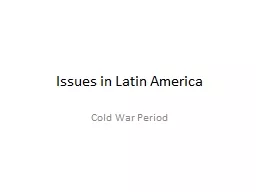

Cold War Period TODAYs OBJECTIVES Explain the political context in Latin America after WWII Explain how the Cold War affected Latin America Following WWII the political grouping into three worlds ID: 573672
Download Presentation The PPT/PDF document "Issues in Latin America" is the property of its rightful owner. Permission is granted to download and print the materials on this web site for personal, non-commercial use only, and to display it on your personal computer provided you do not modify the materials and that you retain all copyright notices contained in the materials. By downloading content from our website, you accept the terms of this agreement.
Slide1
Issues in Latin America
Cold War PeriodSlide2
TODAY’s OBJECTIVES:
Explain the political context in Latin America after WWII
Explain how the Cold War affected Latin AmericaSlide3
Following
WWII – the political grouping into three “worlds”:
First World – United States & its alliesSecond World – U.S.S.R. & its alliesThird World – developing nations, many newly independent. nonaligned
nations - not officially aligned with the two superpowers.
T. Loessin / Akins High School
Latin America is mostly considered “3
rd
world” and under the influence of the USA Slide4
Latin America after WWII
During the Cold War, Latin America saw much political change
Inequality and the United States’ control of business and economic interests were sources of tensionThe people and governments fought between more capitalistic economies and socialistic/communist economiesThe USA/USSR were drawn into these conflictsSlide5
Sources of Unrest
A growing gulf between the rich and the poor fueled discontent in the postwar era.
A population explosion contributed to poverty. Increased trade and control from agriculture business in the United States begin a great migration that sent millions of peasants to the cities. 1Slide6
Overview of Political
Forces in Latin America
Most Latin American states had constitutions modeled on those of France and the United States. Yet, real democracy seemed difficult to achieve in nations plagued by poverty and inequality. Conflict between conservatives and reformers contributed to political instability in many nations. Military leaders held power in many Latin American nations.
During the 1960s and 1970s, guerrillas and urban terrorists battled repressive governments in many Latin American countries.
By the mid-1980s, inflation, debt, and growing protests led repressive leaders to step aside.
A number of countries held elections to replace military governments with civilian governments.
Heavy debt burden and economic slowdowns have threatened the success of elected rulers, putting the stability of democratic governments in the region in doubt.
1Slide7
Changing Social Patterns
The Catholic Church has remained a powerful force.
During the 1960s and 1970s, the Church crusaded for social justice and an end to poverty. This movement became known as liberation theology.
Upper-class women had access to education and careers.Rural women often faced hardship and poverty. Women struggled to win change.
City life weakened the extended family.
The struggle to make a living caused some families to fall apart.
In large cities, thousands of abandoned or runaway children roamed the streets.
RELIGIONWOMEN
URBANIZATION
In Latin America, as elsewhere, urbanization brought social upheaval.
1Slide8
The United States and Latin America
The United States was the leading investor and trading partner for most nations in Latin America.
During the Cold War, the United States intervened repeatedly in Latin America to protect its interests and to prevent the spread of communism. The United States saw itself as the defender of democracy and capitalism and the source of humanitarian aid. Many Latin Americans, however, resented living under the shadow of the “colossus of the north.”Latin American nations and the United States worked together in the Organization of American States (OAS). The organization was formed in 1948 to promote democracy, economic cooperation, and human rights.
2Slide9
War and Peace in Central America
During a vicious civil war, right-wing death squads slaughtered anyone thought to sympathize with the leftists.
The United States pressed for reform, but at the same time provided weapons and other aid to help the military battle rebel guerrillas. Fearing communist influence, the United States helped oust Guatemala’s reformist government in 1954.
While the military regained power, decades of civil war ensued, during which the government routinely tortured and murdered critics.
In 1979, revolutionaries called Sandinistas ousted the ruling Somoza family.
Fearing that Nicaragua would become socialist, the United States secretly backed the “
contras” in a long civil war against the Sandinistas. EL SALVADOR
GUATEMALA
NICARAGUAIn Central America, unrest threatened and discontent grew. Fearing the spread of communism, the United States intervened repeatedly in the region.
3Slide10
Regional and Global Issues
Poverty, civil war, and repressive governments caused Latin American immigration to the United States to increase rapidly after the 1970s.
Pressure increased in the United States to halt illegal immigration. Developing nations insisted that they needed to exploit their land and other resources if they wanted economic growth. This came at the expense of the environment.
Drug cartels in Latin America began exporting ever-larger quantities of cocaine and other drugs.
In the 1980s, the United States declared a “war on drugs,” pressing Latin American governments to cooperate with these efforts.
Regional trading blocs gained importance in the 1990s. Such groups created larger markets by lowering trade barriers among neighboring countries.
Examples: NAFTA, Mercosur
REGIONAL TIES
THE DRUG WARSMIGRATION
DEVELOPMENT VERSUS
ENVIRONMENT2